All are connected in the Universe...

Sounds practiced in religion like the church bells, and specific words chanted repeatedly in all religions, are sound energies that impact human cells' rejuvenation.
The Hindu mantra playing here, "Durga Saptasloki", is praising Goddess Durga for all the victories she attained destroying demons - symbolizing the negativities of life. The sound energy of this mantra chanted in Sanskrit, brings positive energies within and environmental existence of the listener.
Mantra Seeking forgiveness from Lord Shiva The science behind is chanting (sound energies) that cleanses the mind, correcting negative thoughts accumulated from a sense of guilt and realization of wrongdoings.

Remain Young
Play Video above
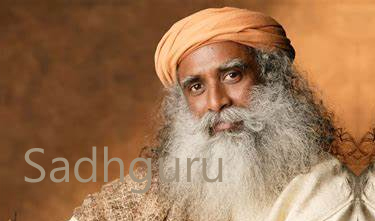
"Everything in the universe began with a perception"
"You become what you perceive yourself to be. There is not a single disease that you cannot cure through your perception.There is nothing you cannot achieve through your perception."

Videos
Video 1
What is the effect of sound on human system?
Play Video below:
Video 2
What is the effect of silence on human system?
Play Video below:
Video 3
Every human can become a creator and get wish fulfilled
Play Video below:
A rare sound of Damaru with Shankha and Temple bells to please Lord Shiva
Shankara Parvathi Stotram- Namashivabayam
Durga Mantras:
Play Video
Durga Gayatri Mantra
Durga Beej Mantra
Durga Saptshati – Argala Stotram
“Science without religion is lame. Religion without science is blind.” - Albert Einstein.
The universe is just one atom. All particles within are connected. Particle physics, a branch of physics, deals with the constitution, properties, and interactions of particles within this universe including humans. In the prayer chanting108 names of Hindu God, Lord Shiva, we say, "Om Sukshma Tanave Namah" meaning the lord who is in the minutest body and, then, he is also prayed as "Om Jagat Vyapine Namah" meaning the Lord who is spread all over world.
All particles we interact with through light force create interactions with the universe. Every action we perform, including religious acts deliver reaction (Einstein's action/reaction theory) and then, we are bound within the cycle of 'action and reaction', Hindus call it 'karma cycle'.
In "karmas", actions prescribed in Hinduism, ritualistic acts are also prescribed in connecting with an universal entity called God. In the video here captioned "Kashi Viswanath Mangal Aarti", includes several natural elements like water, milk, honey, yogurt and sandalwood in bathing the God and then natural elements like flowers and bel leaves are used to energize the God. This is the first ritual held every morning at the Kashi Viswanath temple from morning 3 to 4.
Rituals Explained
Kashi Viswanath Mangal Aarti
Linga Abhishek is a very powerful ritual that pleases Lord Shiva. Ingredients used to bathe the Shiva Linga are water, milk, ghee, sugar, and honey....all natural ingredients to energize the God's presence in a physical structure called "Shiva Lingam". And then, the God is wiped dry with a towel and stacks of flowers are offered in the form of 'life energy'. Mantras are chanted to further energize the God with 'sound energy', and sound of temple bells add to the environmental sound to further energize the God and all present. Here is the Mangal Aarti Video:
The science behind "Om Namah Shivay"

A very popular mantra in Hinduism, Om Namah Shivay simply means "Salutation to Lord Shiva." It is a Panchakshwar (Five Syllebals) Mantra Na – Mah – Shi – Va – Ya, preceded by Om. The sound energy of Om pronounced as AUM - A (awe) vibrates at the back of the throat and reaches the solar plexus - sympathetic nervous system at the pit of the stomach and also vibrates around the chest. The sound vibration of U (oo) is felt in the throat rejuvinating the muscles in the vocal chord. M (mm) literally vibrates the mouth for rejuvination of all muscles within, including the teeth. Followed by OM, chanting of the five syllebals in Namah Shivay rejuvenates five elements the human body is made of which are also the five elements this entire universe is made of – Earth, Water, Fire, Air, and Space. In the mantra Namah Shivaya, Na is earth. Ma is water. Shi is fire. Va is air. Ya is space. Whether it is an individual human body or the larger cosmic body, all are benefited by chanting of Om Namah Shivaya - the sound energy that impacts five elements within and around us.
The rituals involved with this mantra are - pouring water and milk on Shiva Linga, offering Bel leaves, flowers and fruits. The significance of these offerings in scientific terms are energizing the Lingam with elements of nature. Water and milk, both have energizing and purifying effects, flowers and bel leaves also deliver natural 'Living Energy' to the Lingam. Why specific flowers and bel leaves? These are ritualistic beliefs tied to Hindu mythology and stories written in Purans (Hindu scriptures). It is believed that Lord Shiva loves white flowers, especially 'dhatura' or thornapple flowers and Bel leaves.
The most prescribed ritual is simple chanting of "Om Namah Shivaya" and concentration.The sound energy from chanting combined with concentration - mind energy (brain cells producing molecules to store energy) create oneness with the entire universe connecting atomic conditions within and around us - the scientific principle behind particle physics.
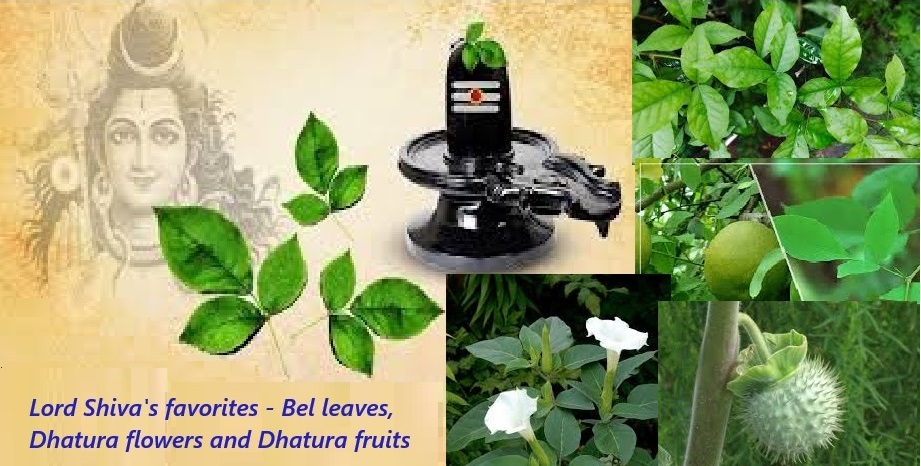
Lord Shiva loves Bel leaves because the triangular shape of the leaves symbolizes Lord Shiva's three eyes and trishul, Lord Shiva's divine powers. Offering bel leaves to Lord Shiva is believed to bring blessings and protection.
Lord Shiva loves Dhatura flowers because, it is mentioned in Hindu scriptures, that Dhatura flower emerged from Lord Shiva's chest when he drank poison during the churning of the ocean symbolizing the transformative power of destruction and regeneration.
Maha Mrityunjaya Mantra
This unique mantra seeks blessings from Lord Shiva for health, wealth and longevity.
The Maha Mrityunjaya mantra origin:
The mantra is found within the Rigveda, a sacred text of Hinduism.
The hymn (7.59.12) is attributed to Vasiṣṭha Maitrāvaruṇi also known as Vaisistha Muni a revered Vedic sage and one of the Saptarishis (seven great sages) in Hinduism, credited as the chief author of Mandala 7 of the Rigveda. While the mantra is attributed to Vasiṣṭha Muni, later, Markandeya Rishi, is said to have composed the mantra and chanted it to gain longevity.
The Maha Mrityunjaya mantra meaning: The mantra is believed to grant liberation from death and promote spiritual growth, invoking divine energy and fostering peace and well-being. "We worship the three-eyed one (Lord Shiva), who is fragrant and nourishes all, and may we be liberated from death, from mortality".
The legend behind the mantra:
There was no child in the house of Lord Shiva's worshiper Rishi Bhrigu. He asked Lord Shiva for a child. Lord Shiva said, "There is no child in your destiny." For your hard devotion, you will be having a son, but he will be only sixteen years old. A son was born in Rishi Bhrigu's house named him Markandeya. The father sent Markandeya to the ashram of the sages for education. Fifteen years later Markandeya returned home after taking education. His parents were depressed. When Markandeya asked them the reason for sadness, the father told Markandeya about his death when he is sixteen. Markandeya says, nothing will happen to him.
Markandeya then went to do penance of Lord Shiva after taking orders from his parents. He composed the Mahamrityunjaya mantra. He kept reciting it for a year. When he was sixteen years, Yamraj came to take him. Markandya was absorbed in devotion to Lord Shiva. When Yamraj proceeded to take his life, Markandeya clung to the Shivling. Lord Shiva appeared carrying the trident and told Yamraj that the boy has been given longevity. Yamraj bowed to Lord Shiva and left. Then Lord Shiva said to Markandeya, "This mantra written by you will be very dear to me. My blessing will always be on whoever chants it". The person chanting this mantra is freed from the fear of death and attains the grace of Lord Shiva. The boy grew up and became Markandeya Rishi.
Here is the mantra chanted by 21 Brahmins:
ॐ त्र्यम्बकं यजामहे सुगन्धिं पुष्टिवर्धनम् ।
उर्वारुकमिव बन्धनान् मृत्योर्मुक्षीय मामृतात् ॥
Om Try-Ambakam Yajaamahe Sugandhim Pushtti-Vardhanam
Urvaarukam-Iva Bandhanaan Mrityor-Mukshiiya Maa-[A]mrtaat ||
Shankar Parvati Stotram
This unique stotram on union of the two inseparable entities - Lord Shiva and Goddess Parvati is believed to invoke the divine love and unity between Shiva and Parvati. Associated with an ideal balanced and harmonious life, this stotram is written by Adi Shankaracharya in praise of Lord Shiva and Goddess Parvati. It says, they are always in best youthful states clinging to each other in tight embrace, their playful love is a festival, they are worshipped by Lord Narayan, Lord Vishnu, Lord Brahma and Lord Indra...Play video. The full stotram meaning is given below:
Meaning:
Salutations to Lord Shiva and Goddess Shivaa,
Who are always in fresh stage of youth,
Who cling to each other in tight embrace,
Of whom one is the daughter of the mountain,
And the other is one whose symbol is a bull
Salutations and salutations to Lord Shankara
And to that Goddess Parvati
Salutations to Lord Shiva and Goddess Shivaa,
Whose playful love is a festival,
Who grant boons to those who salute them,
And whose feet is worshipped by Lord Narayana,
Salutations and salutations to Lord Shankara
And to that Goddess Parvati
Salutations to Lord Shiva and Goddess Shivaa,
Who ride on the divine bull,
Who are worshipped by Vishnu, Brahma and Indra,
And whose bodies are anointed with Sandal and holy ash,
Salutations and salutations to Lord Shankara
And to that Goddess Parvati
Salutations to Lord Shiva and Goddess Shivaa,
Who are the lord and lady of the universe,
Who are always victorious,
And who are worshipped by Indra and his chiefs,
Salutations and salutations to Lord Shankara
And to that Goddess Parvati
Salutations to Lord Shiva and Goddess Shivaa,
Who are themselves the greatest medicine
Who are happy to hear panchakshari repeated,
And who create, rule and destroy the universe,
Salutations and salutations to Lord Shankara
And to that Goddess Parvati
Salutations to Lord Shiva and Goddess Shivaa,
Who are very pretty,
Who are ever interested
In the lotus like heart of devotees,
And who do not have any other wish,
Except the good of the world,
Salutations and salutations to Lord Shankara
And to that Goddess Parvati
Salutations to Lord Shiva and Goddess Shivaa
Who destroy the effects of the kali age,
Who has a body with famished one on one side,
And a pretty one on the other side,
And who are the Gods living on mount Kailasa,
Salutations and salutations to Lord Shankara
And to that Goddess Parvati
Salutations to Lord Shiva and Goddess Shivaa,
Who destroy all that leads to bad effects,
Who are one and only one in this entire world,
Who have a sharp intelligence,
And who has a very deep memory of what they hear,
Salutations and salutations to Lord Shankara
And to that Goddess Parvati
Salutations to Lord Shiva and Goddess Shivaa,
Who are the solace for all who surrender,
Who have sun, moon and fire as eyes,
And whose lotus face resembles the full moon in the sky,
Salutations and salutations to Lord Shankara
And to that Goddess Parvati
Salutations to Lord Shiva and Goddess Shivaa,
Who attract all the people of the world,
Who do not have old age death and other imperfections,
And who are worshipped by Lord Vishnu and Lord Brahma,
Salutations and salutations to Lord Shankara
And to that Goddess Parvati
Salutations to Lord Shiva and Goddess Shivaa,
Who are our immediate solace in difficult times,
Who both wear the garland made of Bilwa leaves
And Jasmine flowers,
Who are resplendent with abounding peace,
Salutations and salutations to Lord Shankara
And to that Goddess Parvati
Salutations to Lord Shiva and Goddess Shivaa,
Who protect all beings of this earth,
Whose great intent is to protect the three worlds,
And who are worshipped by all asuras and devas,
Salutations and salutations to Lord Shankara
And to that Goddess Parvati
The science behind the city Kashi (Varanasi/Benaras)
The mysterious Seven Shiva Temples on 79° east longitude in India
The unfound mystery behind seven major Shiva temples built on a straight line across 79° east longitude from north to south India. Who perceived this line and why 79 degrees? Please write to Editor@tristatebulletin.com, if you know.
Kedarnath 79.0669°,Kalahashti 79.7037°, Ekambaranatha- Kanchi 79.7036°, Thiruvanamalai 79.0747°. Thiruvanaikaval 79.7108, Chidambaram Nataraja 79.6954°,
Rameshwaram 79.3129°, Kaleshwaram N-India 79.9067°
Goddess Durga
Durga Gayatri Mantra 108 times -Play Video
Meaning: Om, Let me meditate on the goddess who is daughter of Katyayana. Oh, maiden Goddess, give me greater intellect and enlighten my mind.
Human consciousness and Religion
Rig Veda, an Indian Vedic scripture, speaks a volume about human consciousness and some replicated thoughts found in Darwin’s theory. Western philosophers of the 1630s defined “consciousness” as awareness of ‘internal’ and ‘external’ entities. Rig Veda attaches consciousness to whatever we perceive the universe to be in parallel to what we perceive ourselves to be. Our consciousness evolves with the universe. Where ever we are in our awareness of self and the universe, we are in sync with the evolving universe. A verse from Rig Veda (RV 7.59.12) – Mahamrtynjai Mantra prays to Lord Shiva – “Like a fruit falls off from the bondage of its stem, let me get liberated from life by death without any attachment.” Upliftment of one’s consciousness is the only way to evolve to a higher human intellect.
Goddess Durga

The worship of Goddess Durga is very prominent among Hindus. There are numerous temples dedicated to Goddess Durga. Hindu Goddess Durga is perceived as a combined embodiment of feminine forces – Goddess Kali (destroyer of evil), Lakshmi (giver of wealth and prosperity), and Saraswati (giver of knowlwdge and wisdom). Thus, Goddess Durga is a representation of a united front of all forces perceived as devine. Chanting Goddess Durga mantras simply impact our psychic conditions and rejuvinates our cellular memeories to help recognize negative forces within and around us. Here is a mantra chanted by Hindus to seek protection from Goddess Durga:
Om Dum Durgayei Namaha
This mantra in Sanskrit is chanted for protection against human internal and external negative forces, literally, meaning – ”Salutations to She, who is graceful to the seeker of truth and terrible in appearance to those who would harm devotees of truth.”
A popular Durga mantra:
सर्वमङ्गलमाङ्गल्ये शिवे सर्वार्थसाधिके ।
शरण्ये त्र्यम्बके गौरि नारायणि नमोऽस्तु ते ॥
This mantra is the beginning of reciting glories of Goddess Durga – Devi Mahatmya, translates to – Oh! Goddess, The one who always bestows auspiciosuness, accomplishes all objectives, to you, the mother of the three worlds, O Gauri, I bow to you again and again.
Evolving Images of Durga - The Warrior Goddess with many arms (4,8,10) holding many weapons to fight evils within and around us. Scientifically, she is the symbolic representation of our body chemistry that helps us fight anti-life elements.
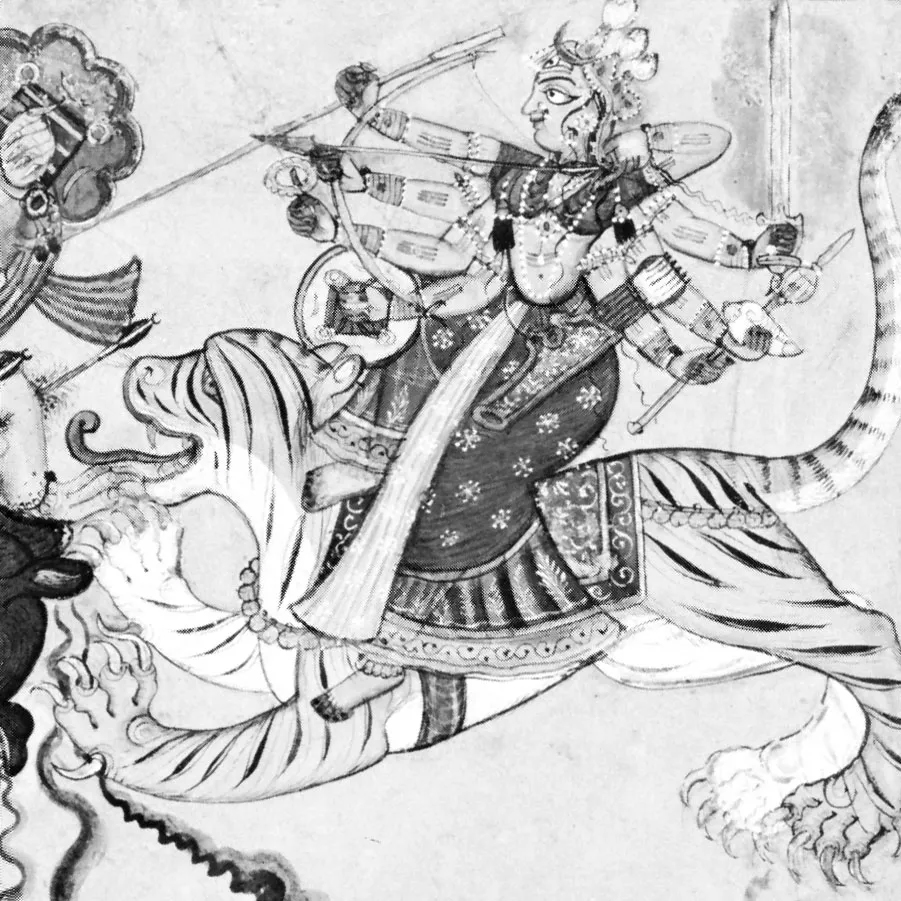

Evolving Durga Imageries
Strikingly significant in evolving Durga imageries is the visualization of arms ranging from 4 to 18. In most Durga temples in North India, she is seen having 8 arms holding weapons and lotus, and conch shell. In Bengal, Orissa and Assam (East India), her image has 10 arms.
In some Hindu Puranas, Goddess Durga is perceived to have 18 arms.
What is common to all images is the visualization of “Mahishasura” – a buffalo head demon being killed in a war scenario. This common theme is well narrated in all related Hindu scriptures signifying that there was a war where Goddess Durga had killed the demon “Mahishasura.”
Later images, especially the Durga perceived by Eastern India (Bengal, Orissa, Asam) see her as a mother accompanied by her four children – Lakshmi, Saraswati, Kartika, and Ganesh. This image is unique which shows she is not alone in the war. Symbolically, the four images added to the Goddess “Warrior Durga” depict natural forces needed to win a war – Ganesh, representing manpower – “Gana Pati” the king of all living beings. Kartika symbolizing the support warrior – “Senapati”. Lakshmi for wealth and Saraswati for the power of speech and related wisdom. Goddess Durga is in support of all these elements needed to win a war.
Goddess Durga is perceived in union with Lord Shiva, represnting hormonal co-existance of male and female in nature – Hindu perception pf the image is called “Ardha-Narishwar”. Here is an image which was created at the Isha foundation representing union of Lord Shiva and Goddess Durga over a famous night called “Shiv Raatri” – the wedding night of Durga and Shiva.
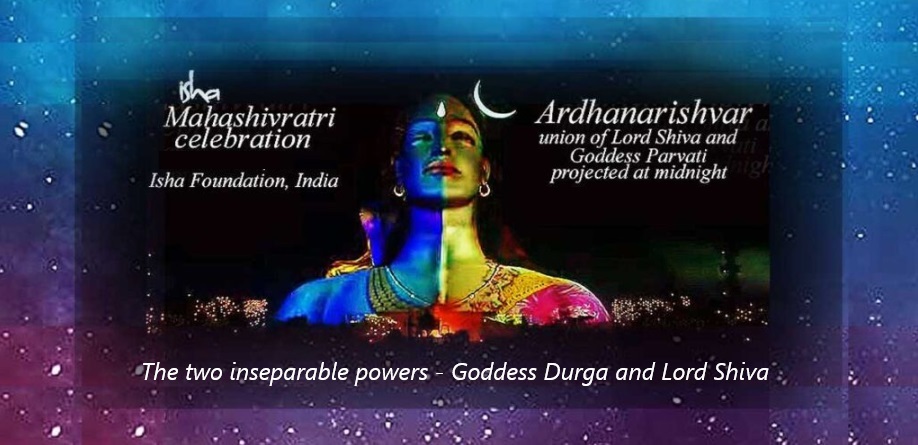
Video on Quantum Healing
Human Consciousness evolves following how the Universe evolves: We become that what we perceive ourselves to be.
Recommended Reading

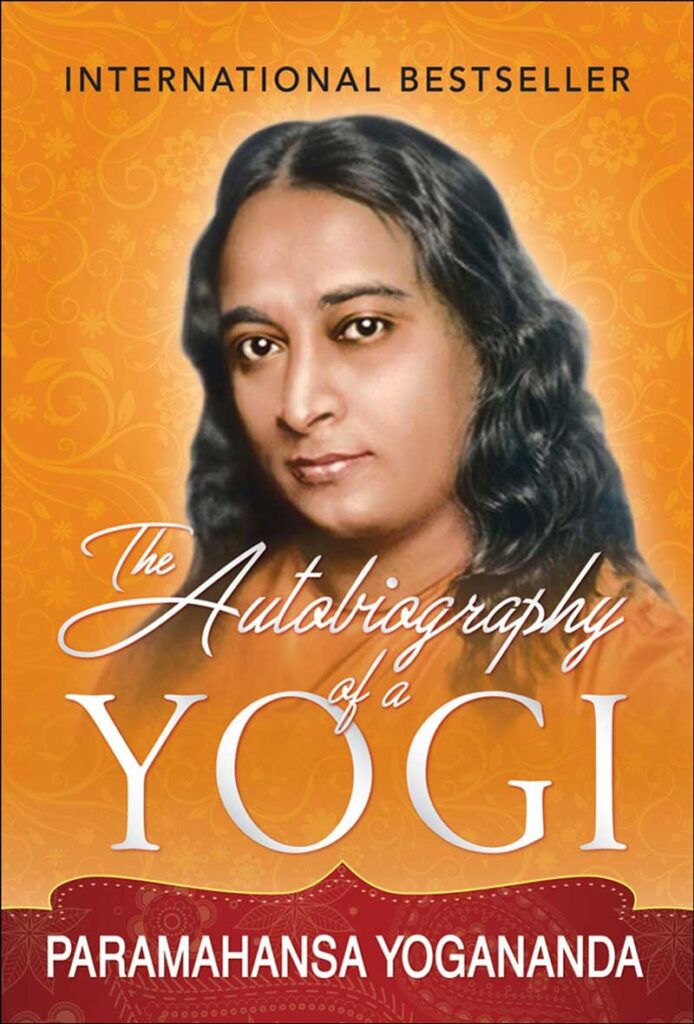
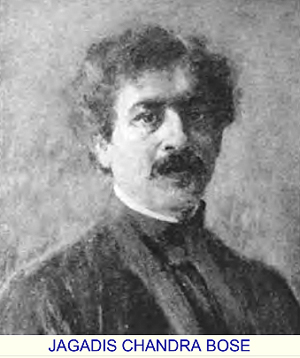
In conversation with Jagadish Chandra Bose: Chapter 8
“Bose was the first scientist to invent wireless…”
The Science of Kriya Yoga: Chapter 26.The Sanskrit root of Kriya is “Kri” to act and react – the natural law of “Cause and Effect”

Reincarnation proven:
Kashi Reborn and Rediscovered: Chapter 28
The Law of Miracles:
Chapter 30. Leo Tolstoy wrote a delightful story, The Three Hermits. Nicholas Roerich summarized the tale….
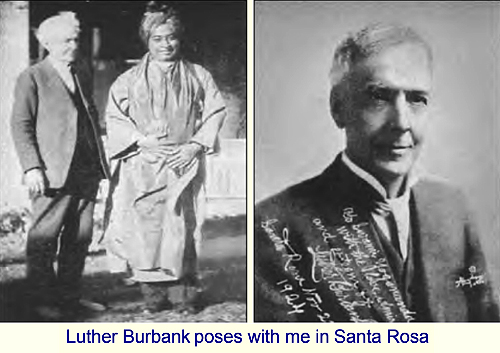
Lurther Burbank:
Chapter 38 The Training of the Human Plant
The Woman Yogi who never eats – Chapter 46: The great woman yogi has not taken food or drink. She employs a certain yoga technique to recharge her body with cpsmic energy from
the ether, sun and air.
The Resurrection of Shri Yukteswar: Chapter 43
“Waves of rapture engulfed me as I beheld the flesh and blood form of Sri Yukteswar”
International Best Seller, Autobiography of a Yogi, the complete book is posted here with reviews from press and prominent personalities. We have included links to FREE downloadable PDF Version and, also, we have included a FREE link to ‘Chapters by Click’ from Wikisource. Both the links are below.
Please send your reviews to editor@tristatecommunitybulletin.com. We will respond back and interesting communication will be posted for all readers.
Autobiography of a Yogi
By Paramhansa Yogananda

Editor’s note:
Sushmita Dutta
sushmitadutta@tristatecbulletin.com
We found justifiable reasons in including Autobiography of a Yogi because many chapters of this book directly relate to scientific explanations behind spiritual experiences. The chapter on “Kashi Reborn”, for an example, (Chapter 28: Kashi, Reborn and Rediscovered) relates to the Hindu philosophy of ‘re-birth’ and also the scientific principle behind “Particle Physics” – every particle in this universe, ignoring the physical distance, interact with each other. Yogananda’s guru, Shri Yukteshwar Giri, points his ten fingers to feel the vibrations of a newborn, Kashi, who was his disciple in Kashi’s previous birth. The physical existence of a living entity is constant whether in a structured body or in atomic condition. And, Yoganand’s guru was simply getting impulses from the re-birth of a disciple he knew named Kashi in a different time and space.
In another chapter, Chapter 46: The Woman Yogi who Never Eats (Giri Bala), Yoganand talks about a “Non-Eating Saint”, – a simple, village woman who began practicing yoga that would transfer universal energy, the Sun’s energy specifically to sustain her physical body. She began doing the yoga from the time she was a teenager and when Yganand and other scientists met her, she was 72 years old, surviving all these years without any food to which investigating scientists found logical reasons.
Many other chapters in this book relate to scientific principles behind spiritual experiences. We have provided two different links to read this book chapter by chapter and also download a PDF absolutely free of any cost. Enjoy!
Reviews:
“I am grateful to you, for granting me some insight into this fascinating world.” – Thomas Mann, Nobel Laureate
“In a very readable style…Yogananda presents a convincing case for yoga, and those who ‘came to scoff’ may remain ‘to pray.'” – San Francisco Chronicle
“I keep stacks of Autobiography of a Yogi around the house, and I give it out constantly to people. When people need ‘regrooving,’ I say read this, because it cuts to the heart of every religion.” – George Harrison, Beatles
“Autobiography of a Yogi is justifiably celebrated as one of the most entertaining and enlightening spiritual books ever written.”
– Tom Butler-Bowdon, Author, 50 Spiritual Classics
“Among the thousands of books that are published each year, there are those that entertain, those that instruct, those that edify. A reader can consider himself fortunate if he finds one that does all three. Autobiography of a Yogi is rarer still — it is a book that opens windows of the mind and spirit.”
– India Journal
“I met Paramhansa Yogananda on teo occasions….The moment I started reading this book, it did something to me that I can’t describe.
I read many books on yoga, by yogis;but I was never impressed as with this book, It has some magic in it.” – Ravi Shankar, Indian Classical musician
Please send your reviews to editor@tristatecommunitybulletin.com
We will respond back and interesting communication will be posted for all readers wanting to know about science behind spirituality.
Free links: Autobiography of a Yogi
Download PDF of Autobiography of A Yogi:
https://drive.google.com/file/d/
0B6wFYDlBeznQa1VxeXdBS2RfUEE/edit?resourcekey=0-zgI9Z3a9o6YtDsRus2AB8Q
This site is upgraded EVERY MONDAY with new topics and findings by participating Science and Spirituality experts and well-known leaders. Last upgrade: Monday, March 24, 2025
